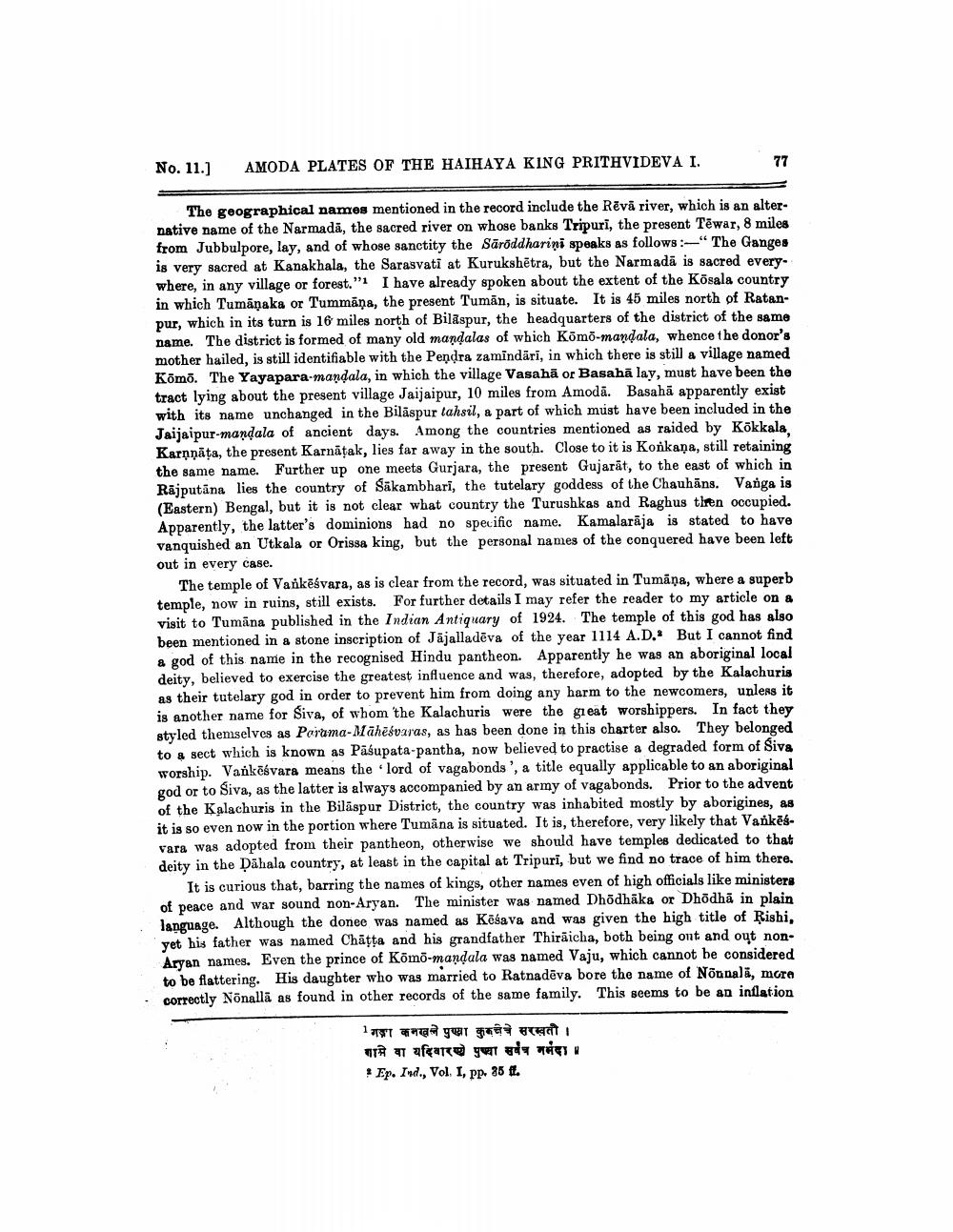________________
No. 11.]
AMODA PLATES OF THE HAIHAYA KING PRITHVIDEVA I.
77
The geographical names mentioned in the record include the Rēva river, which is an alternative name of the Narmada, the sacred river on whose banks Tripuri, the present Têwar, 8 miles from Jubbulpore, lay, and of whose sanctity the Säröddharini speaks as follows: The Ganges is very sacred at Kanakhala, the Sarasvati at Kurukshetra, but the Narmada is sacred everywhere, in any village or forest." I have already spoken about the extent of the Kōsala country in which Tumanaka or Tummaņa, the present Tuman, is situate. It is 45 miles north of Ratanpur, which in its turn is 16 miles north of Bilaspur, the headquarters of the district of the same name. The district is formed of many old mandalas of which Kōmo-mandala, whence the donor's mother hailed, is still identifiable with the Pendra zamindāri, in which there is still a village named Kōmo. The Yayapara-mandala, in which the village Vasaha or Basaha lay, must have been the tract lying about the present village Jaijaipur, 10 miles from Amodā. Basaha apparently exist with its name unchanged in the Bilaspur tahsil, a part of which must have been included in the Jaijaipur-mandala of ancient days. Among the countries mentioned as raided by Kōkkala, Karnņāta, the present Karnatak, lies far away in the south. Close to it is Konkana, still retaining the same name. Further up one meets Gurjara, the present Gujarat, to the east of which in Rajputana lies the country of Sakambhari, the tutelary goddess of the Chauhans. Vanga is (Eastern) Bengal, but it is not clear what country the Turushkas and Raghus then occupied. Apparently, the latter's dominions had no specific name. Kamalaraja is stated to have vanquished an Utkala or Orissa king, but the personal names of the conquered have been left
out in every case.
The temple of Vankesvara, as is clear from the record, was situated in Tumāņa, where a superb temple, now in ruins, still exists. For further details I may refer the reader to my article on a visit to Tumana published in the Indian Antiquary of 1924. The temple of this god has also been mentioned in a stone inscription of Jajalladeva of the year 1114 A.D. But I cannot find a god of this name in the recognised Hindu pantheon. Apparently he was an aboriginal local deity, believed to exercise the greatest influence and was, therefore, adopted by the Kalachuris as their tutelary god in order to prevent him from doing any harm to the newcomers, unless it is another name for Siva, of whom the Kalachuris were the great worshippers. In fact they styled themselves as Porama-Mähesvaras, as has been done in this charter also. They belonged to a sect which is known as Pasupata-pantha, now believed to practise a degraded form of Siva worship. Vankesvara means the lord of vagabonds', a title equally applicable to an aboriginal god or to Siva, as the latter is always accompanied by an army of vagabonds. Prior to the advent of the Kalachuris in the Bilaspur District, the country was inhabited mostly by aborigines, as it is so even now in the portion where Tumana is situated. It is, therefore, very likely that Vankesvara was adopted from their pantheon, otherwise we should have temples dedicated to that deity in the Dahala country, at least in the capital at Tripuri, but we find no trace of him there.
It is curious that, barring the names of kings, other names even of high officials like ministers of peace and war sound non-Aryan. The minister was named Dhōdhāka or Dhodha in plain language. Although the donee was named as Kesava and was given the high title of Rishi, yet his father was named Chaṭṭa and his grandfather Thiräicha, both being ont and out nonAryan names. Even the prince of Komo-mandala was named Vaju, which cannot be considered to be flattering. His daughter who was married to Ratnadēva bore the name of Nonnală, more correctly Nōnalla as found in other records of the same family. This seems to be an inflation
1 गङ्गा कनखले पुण्या कुरुक्षेत्रे सरस्वती । शामे वा यदिवार पुच्या सर्वत्र नर्मदा | Ep. Ind., Vol. I, pp. 35 ff.




